BALTIMORE — The cargo ship Dali that caused the collapse of the Key Bridge experienced several blackouts before even leaving the Port of Baltimore, federal investigators say.
This, along with the events of March 26 and an overview of the Dali, were detailed in an initial report released by NTSB on Tuesday.
According to the report's findings, on March 25, the ship had a blackout nearly 10 hours before leaving the port while undergoing maintenance. The power outage was caused by a crewmember who mistakenly closed an inline engine exhaust damper, causing the ship's engine to stall. A backup generator automatically came on. It continued to run until insufficient fuel pressure caused it to kick off again, resulting in the second blackout of the day. That's when the crew made changes to the cargo ship's electrical configuration, changing from using one transformer and breaker system it had been using for months to another that was in use when the ship departed the following day.
Investigators did not say if those power issues had anything to do with the blackout that caused the ship to hit the bridge and its immediate collapse. Adding that a full investigation could take over a year.
“The NTSB is still investigating the electrical configuration following the first in-port blackout and potential impacts on the events during the accident voyage," the report reads.
According to the newly released report by federal investigators, here's what happened on March 26:
On March 26, just after midnight, a senior pilot and an apprentice pilot got on the Dali ship, which was about to depart from Baltimore to Sri Lanka. During the exchange, the senior pilot asked about the ship's working condition, and the captain said the ship was in good working order.
Nearly 30 minutes later, two tugboats pulled the Dali away from the dock and the ship entered the Fort McHenry Channel. At this time, all three steering pumps (which turned the ship's single rudder) were online and working. A short time later, the senior pilot gave orders for the tugboats to be let go, as is standard practice, and the senior pilot turned over control to the apprentice pilot who began preparing the ship to go under the bridge.
At 1:25 a.m., when the Dali was just over a half mile away from the bridge, a primary electrical breaker that fed most of the ship's equipment and lighting tripped unexpectedly, causing a blackout. The main engine shut off after the pumps lost power and the ship lost main propulsion, meaning its propeller stopped.
This loss of electrical power stopped all three steering pumps. Therefore, the rudder was unable to be moved.
At this time, the apprentice pilot called the senior pilot, who was supervising, to take over.
According to the crew, the emergency generator kicked in and power was restored. Crewmembers called for an assist from tug boats and the senior pilot ordered the ship's anchor to be dropped.
A second blackout then occurred and a call was made to warn traffic in the waterway. The ship then hit a main support pier on the bridge causing it to collapse within seconds.
Tug boats did not reach the Dali before it hit the bridge.
The ship was able to issue a mayday alert in just enough time for police to stop traffic, but not fast enough to save the workers filling potholes on the bridge. Seven workers were in their cars and fell with the bridge. One worker was able to free himself from his truck and was rescued by a police boat shortly after the collapse.
Multiple agencies searched for survivors throughout March 26. The US Coast Guard suspended the search later that evening, and efforts transitioned to recovery.
Six victims were later recovered by divers.
The Coast Guard has classified the collapse as a major marine casualty.
More information is expected to come out as investigators continue their probe into the bridge collapse. Tuesday's findings are likely a fraction of what will be presented in the final report, which is expected to take over a year.
The FBI has also launched a criminal investigation into the circumstances surrounding the collapse.
READ MORE:
WATCH NEXT:

